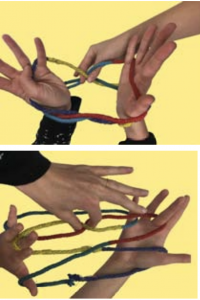Emilia Louisa Pucci, and independent artist and designer, worked in the lab this summer exploring textile-based display. We created this circular weave using wool dyed with thermochromic pigments and embroidered heating wire. When current is supplied to the heating wire, the wire heats up and the yarns next to the wire change colors. We arranged the heating wire into several distinct spirals that become visible the longer the viewer is present. What was most interesting about this display is the slowness and the idea that the display will likely never repeat the same pattern. The heat created by the yarns varies based on environmental factors and creates a slightly different abstract pattern each use.
Another interesting discovery from this project is that, since wool is a great insulator, the heating wire running along the backside of the fabric is not visible on the surface. This allowed us to create an animation on the surface of the fabric and a different “negative space” animation that was only visible on the back side of the fabric.
Emilia presented the piece at Intersections, a conference on collaborations in textile design research in the UK. She equipped the final installation with a proximity sensor that would trigger the animation upon the viewers approach. The installation runs off an Arduino, motor driver (to give the heating yarns the current they require), and 12V power supply.

 Collaborative survival is a term coined by anthropologist Anna Tsing to describe how our (human) ability to persist as a species is deeply entangled with and dependent upon the health of a multitude of other species. We (Jen Liu, Daragh Byrne, and Laura Devendorf) wrote a paper that explores how this term inspires design. Specifically, Jen Liu reflects on collaborative survival within the context of designing tools for mushroom foraging. Photo Credit: Jen Liu. More Information:
Collaborative survival is a term coined by anthropologist Anna Tsing to describe how our (human) ability to persist as a species is deeply entangled with and dependent upon the health of a multitude of other species. We (Jen Liu, Daragh Byrne, and Laura Devendorf) wrote a paper that explores how this term inspires design. Specifically, Jen Liu reflects on collaborative survival within the context of designing tools for mushroom foraging. Photo Credit: Jen Liu. More Information: 
